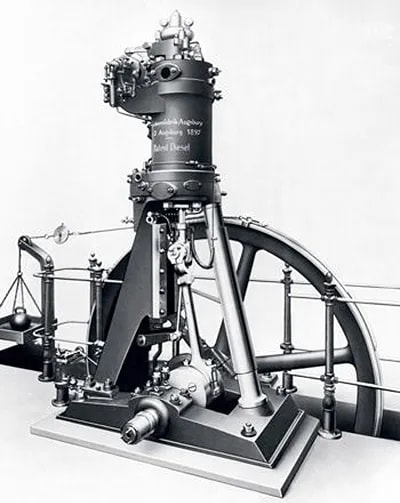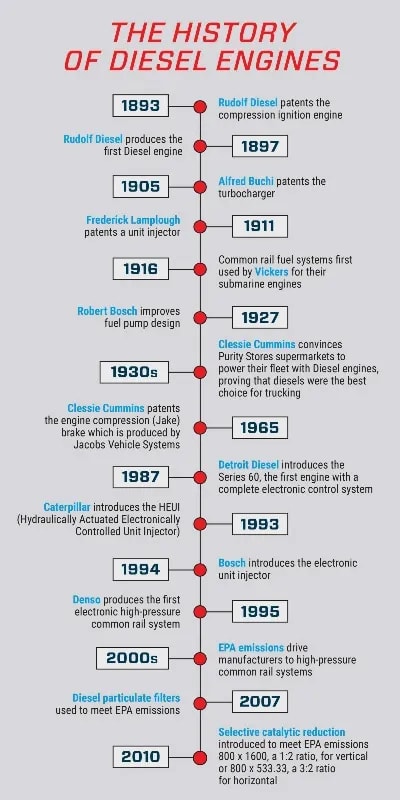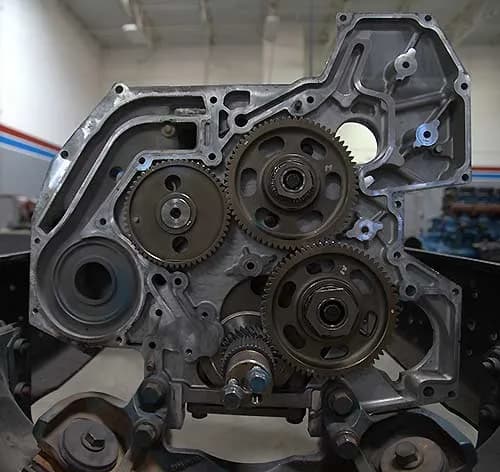How To Become a Diesel Mechanic: Qualifications & Requirements
Interested in training to become a diesel mechanic? Learn about diesel mechanic qualifications and requirements here and how UTI can help!
Rudolf Diesel, who is known as the diesel inventor, created the diesel engine in the 1890s, aiming to develop a highly efficient engine by converting heat into power. His successful prototype in 1897 demonstrated a significant efficiency improvement over the steam engines of the time.
Diesel engines operate on a four-stroke combustion cycle (intake, compression, combustion and exhaust), utilizing the heat of compressed air to ignite fuel. This internal combustion process makes diesel engines more efficient than steam-powered engines, which are external combustion engines.
The diesel engine has undergone significant developments since its invention, including turbocharging introduced by Alfred Büchi in 1925 to increase efficiency, and improvements in fuel-injection pumps by Robert Bosch in 1927. Modern diesel engines are also equipped with technology to reduce emissions and improve fuel economy.
Diesel engines have been widely used in various applications, including commercial trucking, passenger vehicles and as stand-alone generators across different industries. Their evolution continues with a focus on emissions control, cost and efficiency.
Individuals interested in working on diesel engines can pursue careers as diesel generator technicians or mechanics. Training programs, such as those offered by Universal Technical Institute (UTI), provide hands-on education and specialized training for specific manufacturers, preparing graduates to pursue careers in this field.1,18
Knowing the history of diesel engines can help with understanding what they do and how they function. It also helps show their importance as time has passed, so if you’re curious, keep reading to find out more!
The invention of the first diesel engine goes way back, all the way to the 1890s. Since their introduction, they have remained one of the most common engines used in power-generation applications. They have been useful in a variety of industries and functionalities.
Given their rich history and the fact that they are still widely used today, those interested in working on diesel engines have a variety of careers they can pursue. Diesel generator technicians or mechanics work on these powerful engines and generator systems.
Diesel engines are attached to generators at factories, and then it’s up to generator techs to help set up the equipment so it can produce the voltage/amperage the customer specifies. After setup, techs can perform service on the engine and generator set.
In the 1870s, steam was the main supplier of power for factories and trains. Steam-powered cars were even being produced alongside those using internal combustion engines.
Rudolf Diesel was a student learning about thermodynamics at the time, and he got the idea for creating an engine that would be highly efficient and convert the heat it generated into power. He got to work developing what would become the first diesel engine.
He set up his first shop in 1885 to start the development of this new engine and to put his theories into practice. One of his hypotheses was that higher amounts of compression would lead to higher efficiency and power.
Diesel received patents for his designs during the 1890s. The first diesel engine prototype was built in 1893, though the first engine test was unsuccessful, so it was back to the drawing board.

Image credit: dieselnet.com
In 1897, Diesel produced successful results after many improvements and tests. In February of that year, he was able to show an efficiency of 26.2% with the engine. Compared with the steam engine popular at the time, the engine Diesel had developed was more efficient by 16.2%.
Diesel engines, like gasoline engines, are considered internal combustion engines. This means fuel is burned inside the main part of the engine where the power is produced. This made diesel engines more efficient than the steam-powered engines at the time, which were external combustion engines that burned fuel outside the cylinders of the engine.
Diesel engines use four-stroke combustion cycles to operate. These include:
The heat of the compressed air is what ignites fuel in a diesel engine. Modern diesel engines are up to twice as efficient as gasoline engines, meaning you can travel farther on the same amount of fuel.
This timeline shows the history of the diesel engine, including some of the key developments and updates with the diesel engine through the years:

Rudolf Diesel had an inquisitive mind at a young age. At just 14, he wrote a letter to his parents letting them know he wanted to become an engineer. After studying at a few different schools, Diesel received a merit scholarship from the Royal Bavarian Polytechnic of Munich.
Carl von Linde, one of Diesel’s professors in Munich, allowed Diesel to assist him at an ice and refrigeration plant. After a year, Diesel had become the director of the plant and helped manage corporate research. During this time, he researched thermal and fuel efficiency.
Diesel had the intention of developing an internal combustion engine and worked on the idea for several years, which led to his introduction of a prototype in 1893 and the first diesel engine production model in 1897.
While he is credited as the “diesel engine inventor,” a look into history shows that Diesel received criticism from multiple sources as to whether he had created something new. German entrepreneur Emil Capitaine was one such critic who claimed to have built an engine in the same manner as Diesel. He ended up losing a patent lawsuit against Diesel.
Richard Hornsby & Sons of England had patented a “heavy-oil” engine in the 1890s before Diesel received a patent for his engine. It was shown that Diesel’s designs were different when it came to the compression ratio of the engine. He used high compression, while Hornsby & Sons' version sprayed fuel into a pre-chamber. The Diesel design ended up being more favorable as it was more adaptable and didn’t need external heat to start.
The high efficiency and simplicity of Diesel’s engine was something that made it an immediate success. By 1898, Diesel had become a millionaire. Unfortunately, he was unable to revel in his accomplishments or riches for too long.
In 1913, Diesel boarded a ship bound for a meeting with the Consolidated Diesel Manufacturing Company in London. However, he was never seen alive again. His cabin was empty in the morning, and his hat and coat were found near one of the ship’s railings.
It was assumed Diesel had jumped overboard, motivated in part by financial problems. He had given his wife a bag with instructions not to open it until the next week. It contained cash and financial statements that revealed the deep debt the family was in. While Diesel’s death was ruled a suicide, rumors that he was murdered still arose.
While mystery still surrounds the death of Rudolf Diesel, the engine he created was revolutionary at the time and continued to be developed. The engine itself was much more efficient at the time than steam-powered varieties, but diesel engines of today are quite different.
In 1925, Swiss engineer and inventor Alfred Büchi was able to combine his turbocharging technology with a diesel engine and increase efficiency by more than 40%. Many modern diesel engines utilize Büchi’s principles and are turbocharged.
Fuel-injection pumps were improved upon and introduced in 1927 by German inventor and industrialist Robert Bosch, helping to increase the fuel economy and efficiency of the engines. The first passenger vehicle with a diesel engine was launched by Mercedes-Benz in 1936.

By the 1960s, diesel engines were the top source of power for the commercial trucking industry. The United States enacted the Clean Air Act in 1963 to help reduce and control pollution, and through the years, there have been various diesel engine advancements to help meet these guidelines.
Since the mid-2000s, diesels have become equipped with various new parts to help reduce emissions and make them more environmentally friendly. Cummins released next-generation types of diesel engines in 2017 that have redesigned emission controls and benefits to fuel economy.
Diesel engines have been used in commercial trucking and the general car market, but they’re also used for stand-alone generators for use in a range of industries. They continue to become more advanced in the realm of emissions control, with a focus on cost and efficiency as well.
The gas engine came first. Gasoline gained prominence when the automobile was invented in 1892, while the first diesel engine wasn’t produced until 1897.
Due to its superior efficiency, equipment previously powered by steam engines switched to diesel, including locomotives, ships and factory equipment.
Diesel engines made the transportation industry more efficient. Before their invention, steam engines were the primary source of power, which required copious amounts of coal to run. This was expensive and inefficient for transportation companies.
Find yourself interested in taking diesel mechanic classes? You can enroll in the Diesel Technology program at Universal Technical Institute (UTI) and graduate in 45 weeks.7 There are even specialized training programs that give you hands-on education with products from specific manufacturers, including Cummins, Peterbilt and Freightliner.15
Take steps toward your potential future and pursuing an exciting career! You can request more information here.
Universal Technical Institute of Illinois, Inc. is approved by the Division of Private Business and Vocational Schools of the Illinois Board of Higher Education.